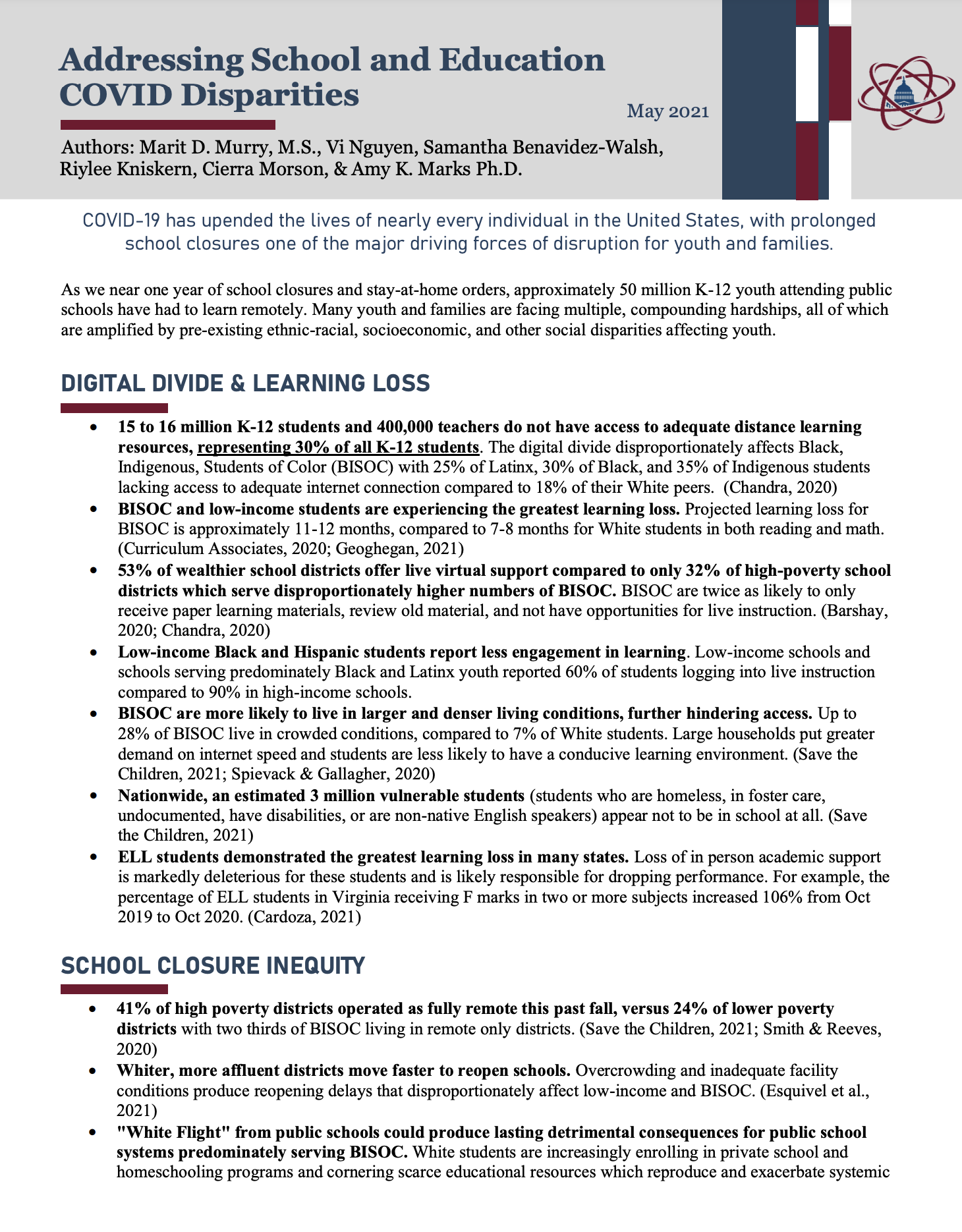
COVID-19 has upended the lives of nearly every individual in the United States, with prolonged school closures one of the major driving forces of disruption for youth and families.
As we near one year of school closures and stay-at-home orders, approximately 50 million K-12 youth attending public schools have had to learn remotely. Many youth and families are facing multiple, compounding hardships, all of which are amplified by pre-existing ethnic-racial, socioeconomic, and other social disparities affecting youth.
Digital Divide & Learning Loss
- 15 to 16 million K-12 students and 400,000 teachers do not have access to adequate distance learning resources, representing 30% of all K-12 students. The digital divide disproportionately affects Black, Indigenous, Students of Color (BISOC) with 25% of Latinx, 30% of Black, and 35% of Indigenous students lacking access to adequate internet connection compared to 18% of their White peers. (Chandra, 2020)
- BISOC and low-income students are experiencing the greatest learning loss. Projected learning loss for BISOC is approximately 11-12 months, compared to 7-8 months for White students in both reading and math. (Curriculum Associates, 2020; Geoghegan, 2021)
- 53% of wealthier school districts offer live virtual support compared to only 32% of high-poverty school districts which serve disproportionately higher numbers of BISOC. BISOC are twice as likely to only receive paper learning materials, review old material, and not have opportunities for live instruction. (Barshay, 2020; Chandra, 2020)
- Low-income Black and Hispanic students report less engagement in learning. Low-income schools and schools serving predominately Black and Latinx youth reported 60% of students logging into live instruction compared to 90% in high-income schools.
- BISOC are more likely to live in larger and denser living conditions, further hindering access. Up to 28% of BISOC live in crowded conditions, compared to 7% of White students. Large households put greater demand on internet speed and students are less likely to have a conducive learning environment. (Save the Children, 2021; Spievack & Gallagher, 2020)
- Nationwide, an estimated 3 million vulnerable students (students who are homeless, in foster care, undocumented, have disabilities, or are non-native English speakers) appear not to be in school at all. (Save the Children, 2021)
- ELL students demonstrated the greatest learning loss in many states. Loss of in person academic support is markedly deleterious for these students and is likely responsible for dropping performance. For example, the percentage of ELL students in Virginia receiving F marks in two or more subjects increased 106% from Oct 2019 to Oct 2020. (Cardoza, 2021)
School Closure Inequity
- 41% of high poverty districts operated as fully remote this past fall, versus 24% of lower poverty districts with two thirds of BISOC living in remote only districts. (Save the Children, 2021; Smith & Reeves, 2020)
- Whiter, more affluent districts move faster to reopen schools. Overcrowding and inadequate facility conditions produce reopening delays that disproportionately affect low-income and BISOC. (Esquivel et al., 2021)
- “White Flight” from public schools could produce lasting detrimental consequences for public school systems predominately serving BISOC. White students are increasingly enrolling in private school and homeschooling programs and cornering scarce educational resources which reproduce and exacerbate systemic achievement disparities by up to 20%. (Dorn et al., 2020)
Barries to Service
- 1 in 5 US families report they do not have enough food to eat with 17 million children facing hunger. BISOC are twice as likely as White children to experience food insecurity. (Save the Children, 2021)
- Black and Latinx families are having an especially difficult time paying rent and fearing eviction.28% of Black and 24% of Latinx households are behind on payments compared to 12% of White households (Save the Children, 2021)
- Emergency Rooms are receiving spikes in mental health related visits from youth.School closures, financial strain, illness, and loss of loved ones increase suicide risk in children. Communities of color are particularly vulnerable to these challenges (Chatterjee, 2021).
- Over half of all children who have died from COVID were BIPOC children. In addition, 19% of Black families and 24% of Latinx families have had a family member die from COVID. (Save the Children, 2021)
Policy Recommendations
- Close the digital divide. Promote FCC $50 monthly internet subsidy to low-income families through partnerships with community institutions and leaders and disseminate multi-lingual and accessible information.
- Support re-engagement and drop-out prevention, specifically for vulnerable youth disengaged from school, by funding non-profits, case management, and outreach services in hardest hit communities
- Direct funds to embed mental health services in schools and communities most affected by pandemic and equip educators through training and resources to help students cope with stressors and loss.
- Create opportunities for lower income youth to learn together. Publicly funded learning hubs for low-income youth and summer learning programs targeting most vulnerable youth (i.e. ELL, homeless youth, you with special education services) to combat disparate learning loss.
- Ensure students have basic needs. Many families are facing multiple hardships, requiring integrated services. Partnerships between schools, community, and social organizations to support families can address the intersection of need, as well as extend and expand key federal programs such as SNAP benefits.
- Implement fair tax strategies for education and school funding that is sufficient and equitable, with less reliance on geographically bound revenues that perpetuate inequitable streams of funding in public schools.
End Notes / References
- Barshay, J. (2020). Survey reveals stark rich-poor divide in how U.S. children were taught remotely during the spring school closures. https://hechingerreport.org/proof-points-survey-reveals-stark-rich-poor-divide-in-how-u-s-children-were-taught-remotely-during-the-spring-school-closures/
- Cardoza, K. (2021) Millions of kids learn English at school. Teaching them remotely hasn’t been easy. The Coronavirus Crisis. NPR. https://www.npr.org/2021/02/24/964420443/millions-of-kids-learn-english-at-school-teaching-them-remotely-hasnt-been-easy
- Chandra, S., Chang, A., Day, L., Fazlullah, A., Liu, J., McBride, L., Mudalige, T., Weiss, D., (2020). Closing the K–12 Digital Divide in the Age of Distance Learning. San Francisco, CA: Common Sense Media. Boston, Massachusetts, Boston Consulting Group.
- Chatterjee, R. (2021, February 02). Child psychiatrists warn that the pandemic may be driving up kids’ suicide risk. Retrieved March 08, 2021, from https://www.npr.org/sections/health-shots/2021/02/02/962060105/child-psychiatrists-warn-that-the-pandemic-may-be-driving-up-kids-suicide-risk
- Dorn, E., Hancock, B., Sarakatsannis, J., & Viruleg, E. (2020). COVID-19 and student learning in the United States: The hurt could last a lifetime. McKinsey & Company.
- Esquivel, P., Gomez, M., & Blume, H. (2021, February 11). Schools in more affluent areas move faster to reopen than those in low-income communities. Retrieved March 08, 2021, from https://www.latimes.com/california/story/2021-02-11/divide-emerges-covid-school-reopening-rich-poor-areas
- Geoghegan, T. (2021). Childhood in the time of covid. Save the Children. https://www.savethechildren.org/content/dam/usa/reports/advocacy/2021-us-childhood-report.pdf
- Save the Children (2021). How COVID-19 has PUT children’s futures at risk across America. Retrieved March 08, 2021, from https://www.savethechildren.org/us/about-us/resource-library/us-childhood-report
- Smith, E., & Reeves, R. (2020, September 25). Students of color most likely to be Learning online: Districts must work even harder on race EQUITY. Retrieved March 08, 2021, from https://www.brookings.edu/blog/how-we-rise/2020/09/23/students-of-color-most-likely-to-be-learning-online-districts-must-work-even-harder-on-race-equity/
- Spievack, N., & Gallagher, M. (2020, June 23). For students of color, remote learning environments pose multiple challenges. Retrieved March 6, 2021from https://www.urban.org/urban-wire/students-color-remote-learning-environments-pose-multiple-challenges
The Research-to-Policy Collaboration (RPC) works to bring together research professionals and public officials to support evidence-based policy. Please visit their website to learn more.
Key Information
RPC Website
Research-to-Policy Collaboration
More RPC Resources
RPC Resources
Publication DateMay 1, 2021
Topic Area(s)Social Services, Education and Child Development, Equity, Health
Resource TypeWritten Briefs
Share This Page
COVID-19 has upended the lives of nearly every individual in the United States, with prolonged school closures one of the major driving forces of disruption for youth and families.
As we near one year of school closures and stay-at-home orders, approximately 50 million K-12 youth attending public schools have had to learn remotely. Many youth and families are facing multiple, compounding hardships, all of which are amplified by pre-existing ethnic-racial, socioeconomic, and other social disparities affecting youth.
Digital Divide & Learning Loss
- 15 to 16 million K-12 students and 400,000 teachers do not have access to adequate distance learning resources, representing 30% of all K-12 students. The digital divide disproportionately affects Black, Indigenous, Students of Color (BISOC) with 25% of Latinx, 30% of Black, and 35% of Indigenous students lacking access to adequate internet connection compared to 18% of their White peers. (Chandra, 2020)
- BISOC and low-income students are experiencing the greatest learning loss. Projected learning loss for BISOC is approximately 11-12 months, compared to 7-8 months for White students in both reading and math. (Curriculum Associates, 2020; Geoghegan, 2021)
- 53% of wealthier school districts offer live virtual support compared to only 32% of high-poverty school districts which serve disproportionately higher numbers of BISOC. BISOC are twice as likely to only receive paper learning materials, review old material, and not have opportunities for live instruction. (Barshay, 2020; Chandra, 2020)
- Low-income Black and Hispanic students report less engagement in learning. Low-income schools and schools serving predominately Black and Latinx youth reported 60% of students logging into live instruction compared to 90% in high-income schools.
- BISOC are more likely to live in larger and denser living conditions, further hindering access. Up to 28% of BISOC live in crowded conditions, compared to 7% of White students. Large households put greater demand on internet speed and students are less likely to have a conducive learning environment. (Save the Children, 2021; Spievack & Gallagher, 2020)
- Nationwide, an estimated 3 million vulnerable students (students who are homeless, in foster care, undocumented, have disabilities, or are non-native English speakers) appear not to be in school at all. (Save the Children, 2021)
- ELL students demonstrated the greatest learning loss in many states. Loss of in person academic support is markedly deleterious for these students and is likely responsible for dropping performance. For example, the percentage of ELL students in Virginia receiving F marks in two or more subjects increased 106% from Oct 2019 to Oct 2020. (Cardoza, 2021)
School Closure Inequity
- 41% of high poverty districts operated as fully remote this past fall, versus 24% of lower poverty districts with two thirds of BISOC living in remote only districts. (Save the Children, 2021; Smith & Reeves, 2020)
- Whiter, more affluent districts move faster to reopen schools. Overcrowding and inadequate facility conditions produce reopening delays that disproportionately affect low-income and BISOC. (Esquivel et al., 2021)
- “White Flight” from public schools could produce lasting detrimental consequences for public school systems predominately serving BISOC. White students are increasingly enrolling in private school and homeschooling programs and cornering scarce educational resources which reproduce and exacerbate systemic achievement disparities by up to 20%. (Dorn et al., 2020)
Barries to Service
- 1 in 5 US families report they do not have enough food to eat with 17 million children facing hunger. BISOC are twice as likely as White children to experience food insecurity. (Save the Children, 2021)
- Black and Latinx families are having an especially difficult time paying rent and fearing eviction.28% of Black and 24% of Latinx households are behind on payments compared to 12% of White households (Save the Children, 2021)
- Emergency Rooms are receiving spikes in mental health related visits from youth.School closures, financial strain, illness, and loss of loved ones increase suicide risk in children. Communities of color are particularly vulnerable to these challenges (Chatterjee, 2021).
- Over half of all children who have died from COVID were BIPOC children. In addition, 19% of Black families and 24% of Latinx families have had a family member die from COVID. (Save the Children, 2021)
Policy Recommendations
- Close the digital divide. Promote FCC $50 monthly internet subsidy to low-income families through partnerships with community institutions and leaders and disseminate multi-lingual and accessible information.
- Support re-engagement and drop-out prevention, specifically for vulnerable youth disengaged from school, by funding non-profits, case management, and outreach services in hardest hit communities
- Direct funds to embed mental health services in schools and communities most affected by pandemic and equip educators through training and resources to help students cope with stressors and loss.
- Create opportunities for lower income youth to learn together. Publicly funded learning hubs for low-income youth and summer learning programs targeting most vulnerable youth (i.e. ELL, homeless youth, you with special education services) to combat disparate learning loss.
- Ensure students have basic needs. Many families are facing multiple hardships, requiring integrated services. Partnerships between schools, community, and social organizations to support families can address the intersection of need, as well as extend and expand key federal programs such as SNAP benefits.
- Implement fair tax strategies for education and school funding that is sufficient and equitable, with less reliance on geographically bound revenues that perpetuate inequitable streams of funding in public schools.
End Notes / References
- Barshay, J. (2020). Survey reveals stark rich-poor divide in how U.S. children were taught remotely during the spring school closures. https://hechingerreport.org/proof-points-survey-reveals-stark-rich-poor-divide-in-how-u-s-children-were-taught-remotely-during-the-spring-school-closures/
- Cardoza, K. (2021) Millions of kids learn English at school. Teaching them remotely hasn’t been easy. The Coronavirus Crisis. NPR. https://www.npr.org/2021/02/24/964420443/millions-of-kids-learn-english-at-school-teaching-them-remotely-hasnt-been-easy
- Chandra, S., Chang, A., Day, L., Fazlullah, A., Liu, J., McBride, L., Mudalige, T., Weiss, D., (2020). Closing the K–12 Digital Divide in the Age of Distance Learning. San Francisco, CA: Common Sense Media. Boston, Massachusetts, Boston Consulting Group.
- Chatterjee, R. (2021, February 02). Child psychiatrists warn that the pandemic may be driving up kids’ suicide risk. Retrieved March 08, 2021, from https://www.npr.org/sections/health-shots/2021/02/02/962060105/child-psychiatrists-warn-that-the-pandemic-may-be-driving-up-kids-suicide-risk
- Dorn, E., Hancock, B., Sarakatsannis, J., & Viruleg, E. (2020). COVID-19 and student learning in the United States: The hurt could last a lifetime. McKinsey & Company.
- Esquivel, P., Gomez, M., & Blume, H. (2021, February 11). Schools in more affluent areas move faster to reopen than those in low-income communities. Retrieved March 08, 2021, from https://www.latimes.com/california/story/2021-02-11/divide-emerges-covid-school-reopening-rich-poor-areas
- Geoghegan, T. (2021). Childhood in the time of covid. Save the Children. https://www.savethechildren.org/content/dam/usa/reports/advocacy/2021-us-childhood-report.pdf
- Save the Children (2021). How COVID-19 has PUT children’s futures at risk across America. Retrieved March 08, 2021, from https://www.savethechildren.org/us/about-us/resource-library/us-childhood-report
- Smith, E., & Reeves, R. (2020, September 25). Students of color most likely to be Learning online: Districts must work even harder on race EQUITY. Retrieved March 08, 2021, from https://www.brookings.edu/blog/how-we-rise/2020/09/23/students-of-color-most-likely-to-be-learning-online-districts-must-work-even-harder-on-race-equity/
- Spievack, N., & Gallagher, M. (2020, June 23). For students of color, remote learning environments pose multiple challenges. Retrieved March 6, 2021from https://www.urban.org/urban-wire/students-color-remote-learning-environments-pose-multiple-challenges
The Research-to-Policy Collaboration (RPC) works to bring together research professionals and public officials to support evidence-based policy. Please visit their website to learn more.

Key Information
RPC Website
Research-to-Policy Collaboration
More RPC Resources
RPC Resources
Publication DateMay 1, 2021
Topic Area(s)Social Services, Education and Child Development, Equity, Health
Resource TypeWritten Briefs
Share This Page
LET’S STAY IN TOUCH
Join the Evidence-to-Impact Mailing List
Keep up to date with the latest resources, events, and news from the EIC.




